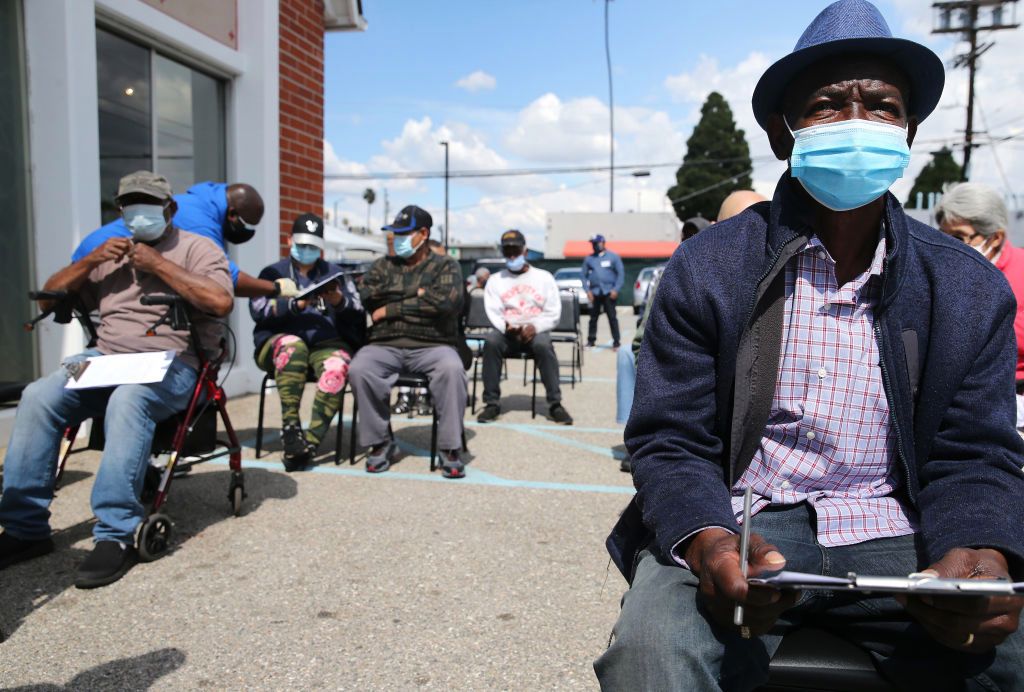
Source: Mario Tama / Getty
Health-related racial disparities have been a disease America has long-struggled to treat. Since the times of slavery when Black Americans were used for medical experiments, inequities have been a persistent plague in America. While some progress has been made, COVID-19 has been like a stress test on the American health care system, and — based on the statistics — the country has underperformed. The pandemic began to hit America in full force in March and early April of 2020.
Here are five ways COVID-19 has disproportionately affected Black Americans and how where we were in March 2020 compares to where we are now.
1. Black People Currently Comprise 15% of COVID Deaths
Where we started: Back in April 2020, in a study of COVID-19 deaths that studied the data of 23 states and Washington DC (the only ones that were reported at the time), Black people dying of COVID-19 averaged 31.37% of the population.
Where we are now: As of March 3, 2021, deaths among black people comprise 15% of all COVID fatalities.
While this may show an overall improvement in the percentage of deaths for Black people, a death rate of 15% still outpaces the percentage of the population that’s black, which sits at only 13%.
2. Black Unemployment is 10.2% vs. 5.2% of Whites
Where we started: Back in the spring of 2020, the unemployment rate of Black Americans stood at 16.7% compared to 14.2% of whites.
Where we are now: Black unemployment, even though it’s lower than in the spring of 2020, is still nearly twice that of whites at 10.2%, compared to 5.2% among their white counterparts.
3. 4,282,980 Black People Are Currently Without Jobs During COVID
Where we started: In the spring of 2020, there were significantly more black people unemployed, at around 7.01 million. As the economy has started to rebound, the effects may be boosting Black job growth. However, the number of Blacks unemployed during COVID is even higher than it was during the Great Recession, which saw 6.22 million Black people unemployed.
Where we are now: Currently, about 4.28 million Black Americans are without a job. This is a marked improvement since the spring of 2020 but still represents a significant portion of Black people in the country, which stands at only 41.99 million.
4. Whites Are 2.2 Times More Likely to Have Been Vaccinated
In a survey that gathered data from state health departments, whites were getting the vaccine at a percentage more than twice that of Black Americans, at an average rate of 2.5% of the population compared to only 1.14% of Black Americans in the same areas. This appears to be a product of both racial discrimination and hesitancy on the part of Black Americans to take the vaccine.
In both the infamous Tuskegee syphilis study and the Henrietta Lacks story, Black Americans were used for medical studies without white doctors first getting their consent. The lack of trust engendered by these incidents, combined with the rushed feeling of Operation Warp Speed, the Trump Administration’s attempt to speed up the vaccination of the American people, may result in feelings of unease and a lack of confidence in the safety of the vaccine.
5. Black Children Are 25% More Likely to Miss School Because of the Pandemic
Even though many American children have missed classes due to the pandemic, Black children are 25% more likely to miss school than their white counterparts. According to a pulse survey performed by the U.S. Census Bureau, a full half of Black and Latino parents said their children had their classes canceled. On the other hand, only 40% of white parents reported the same.
Lessons Learned
The COVID-19 stress test has revealed what many have long known: The racial disparities in America have a significant impact on Black Americans. While this isn’t surprising, the fact that the country has lagged behind in supporting Black people during a viral outbreak—something that is blind to race and ethnicity—starkly underscores the racial divide in the United States. As the country climbs out of the abyss of the pandemic, there will likely be long-term ripple effects on the Black community. The higher unemployment rate, combined with a greater percentage of children missing classes, will likely reverberate through the country’s socioeconomic fabric for years to come.
SEE ALSO:
One Year Later: We’re Not Okay, But We’re Going To Be All Right
Racial Disparities In Vaccine Distribution Demand Equity In Priorities
[ione_media_gallery id=”3917798″ overlay=”true”]
